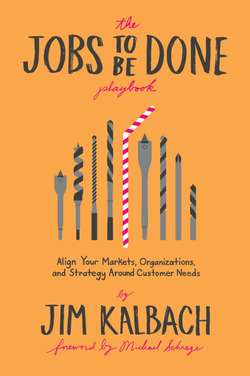Читать книгу The Jobs To Be Done Playbook - Jim Kalbach - Страница 10
На сайте Литреса книга снята с продажи.
About This Book
ОглавлениеThis book is your introduction and guide to the nearly thirty-year-old field of JTBD. It is a collection of existing practices that I call “plays,” borrowing from the metaphor of a sports playbook. Basically, plays are individual techniques that form the building blocks of work in JTBD. You can use them individually or combine them with other plays, which I illustrate in the last chapter. Each play is indicated with the designation “PLAY ”.
The intent is to give you a practical reference to various approaches within the JTBD canon. But keep in mind that this collection is not comprehensive. I include references for you to learn more on the topic. My aim is to open up a broader discussion and exploration of the role of JTBD in business.
The material included here is based on my own investigation into JTBD and various uses of techniques in my work over the past decade. My goal isn’t to introduce a new, competing view of JTBD, nor to present an original method. Instead, I strive to tie existing approaches together by recasting JTBD as a perspective or lens for how to see customers. My hope is that by exposing you to a range of possibilities, you’ll be inspired to adopt JTBD thinking and practices into your own work.
In writing this book, I’ve become acutely aware of the shortcomings of JTBD approaches. Like any method, there are trade-offs. Know that JTBD is certainly no panacea. As you read this book critically, I also encourage you to keep the benefits of JTBD in mind as well.
• First, having a clear unit of analysis—the job—provides a tangible focal point. Needs, emotions, and aspirations are then seen in relation to the job, layered on only after an understanding of the main job.
• Second, because JTBD doesn’t originate from one particular discipline, such as design or marketing, other teams can readily adopt the approach and form insights of their own.
• Third, because JTBD views an individual’s objective independent of technology, the technique future-proofs your thinking. Framing the job as universally as possible better prepares you to create solutions around how customers may act in the future, not tied to the past.
Working with JTBD may feel uncomfortable at first. It takes practice. The rules of formulating a job statement, for instance, are precise. Start small and experiment, and try not to overcomplicate things: a job is often more straightforward than you think. Eventually, you can have everyone in your organization adopt the lens of JTBD. You’ll then have a consistent engine that drives innovation and growth at all levels of an organization.
You might also feel like JTBD overlaps with other existing techniques. In many cases, you’d be right. Just remember that it’s unlikely that you will replace existing processes with a JTBD approach all at once. Instead, you’ll likely start by introducing parts of JTBD into your current workflow little by little. This book is designed to help you do just that.
The good news is that JTBD is compatible with other modern techniques, such as Design Thinking, Agile, and Lean. Together, these approaches can help you transform the way you do business from end-to-end. As you try the techniques presented here, consider how they may fit into a broader program of modern customer-centered activities.
For instance, people familiar with Intuit will point out after reading the story at the beginning of this introduction that the company also practices user-centered design. Their “Design for Delight” program (aka D4D) actively guides product design and development across the company. So while JTBD is not an instant cure-all, it works well in conjunction with other disciplines and fields.
Finally, keep in mind that techniques in JTBD are still evolving. I continually come across novel uses of jobs thinking, and I encourage you to develop your own approach as you explore the topic. Think of this book as a starting point, a beginning to your understanding of JTBD.
